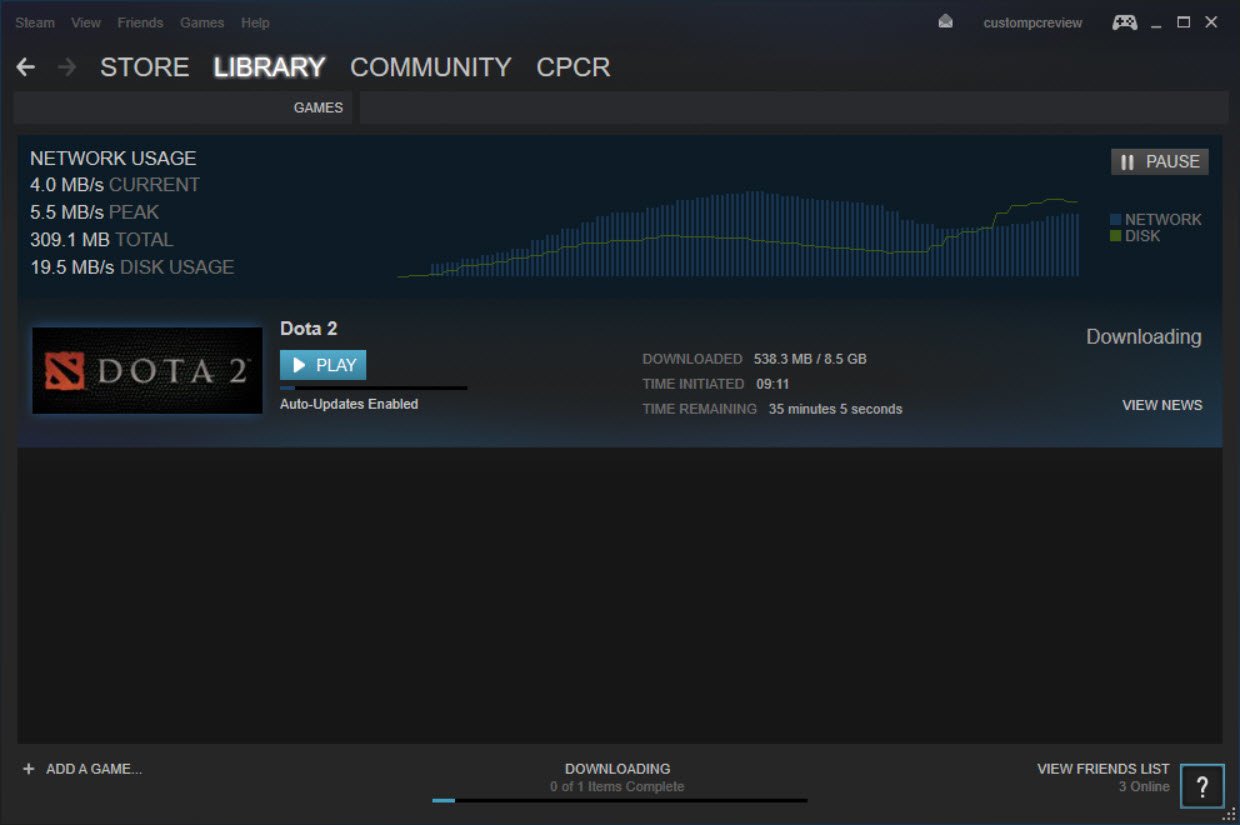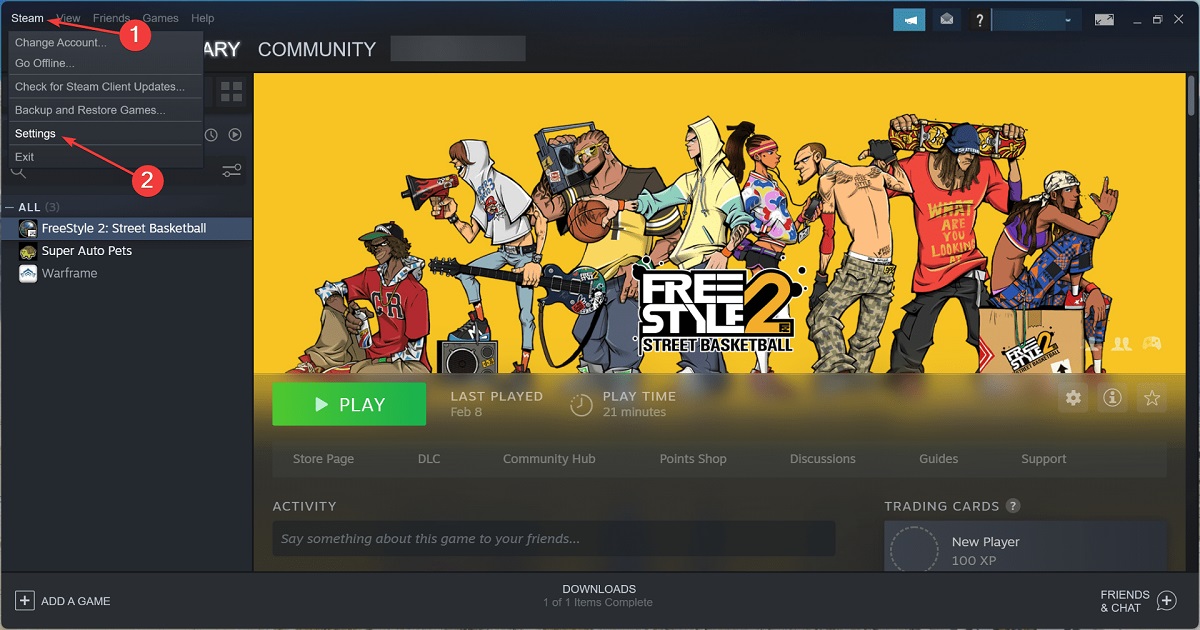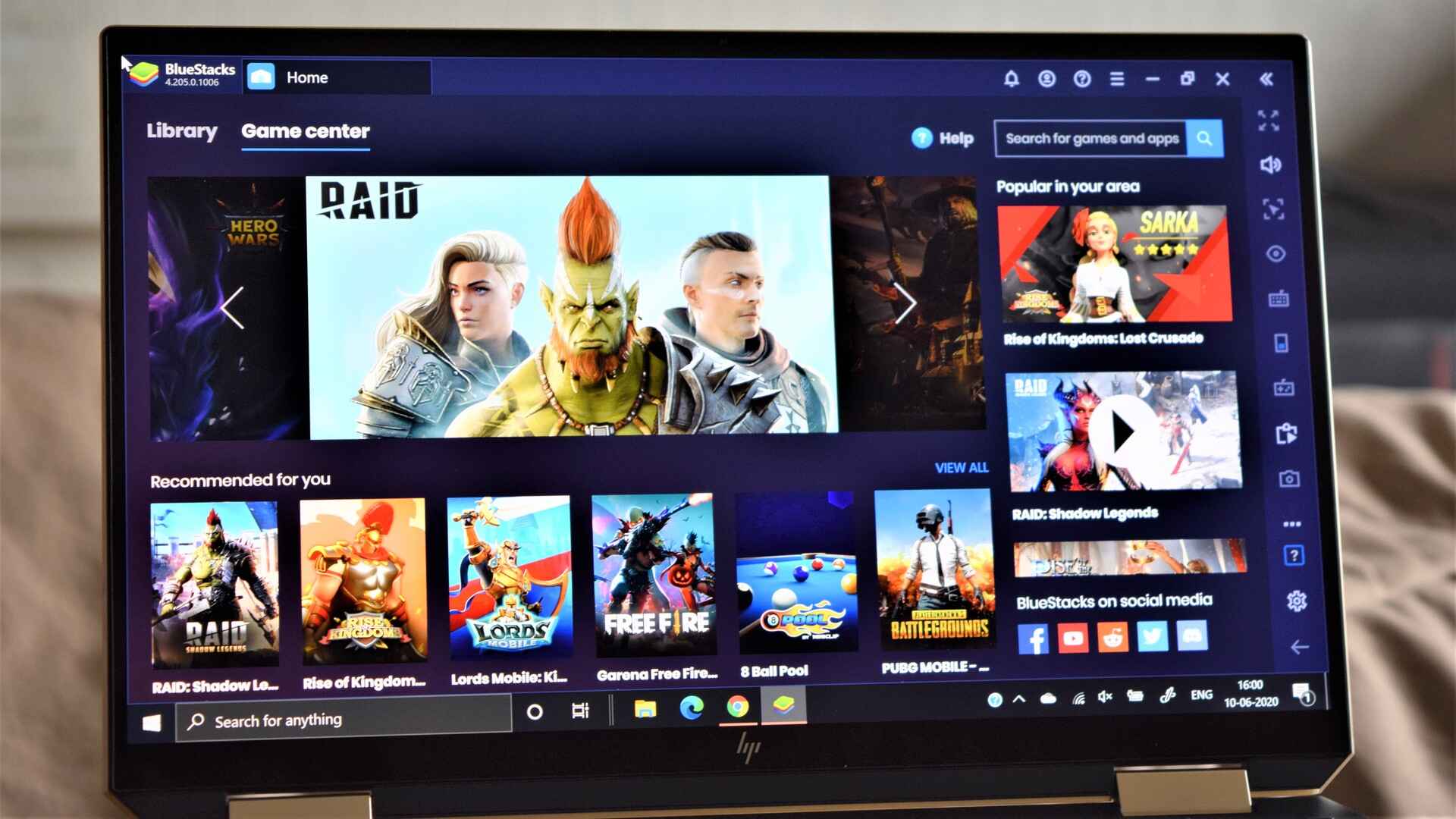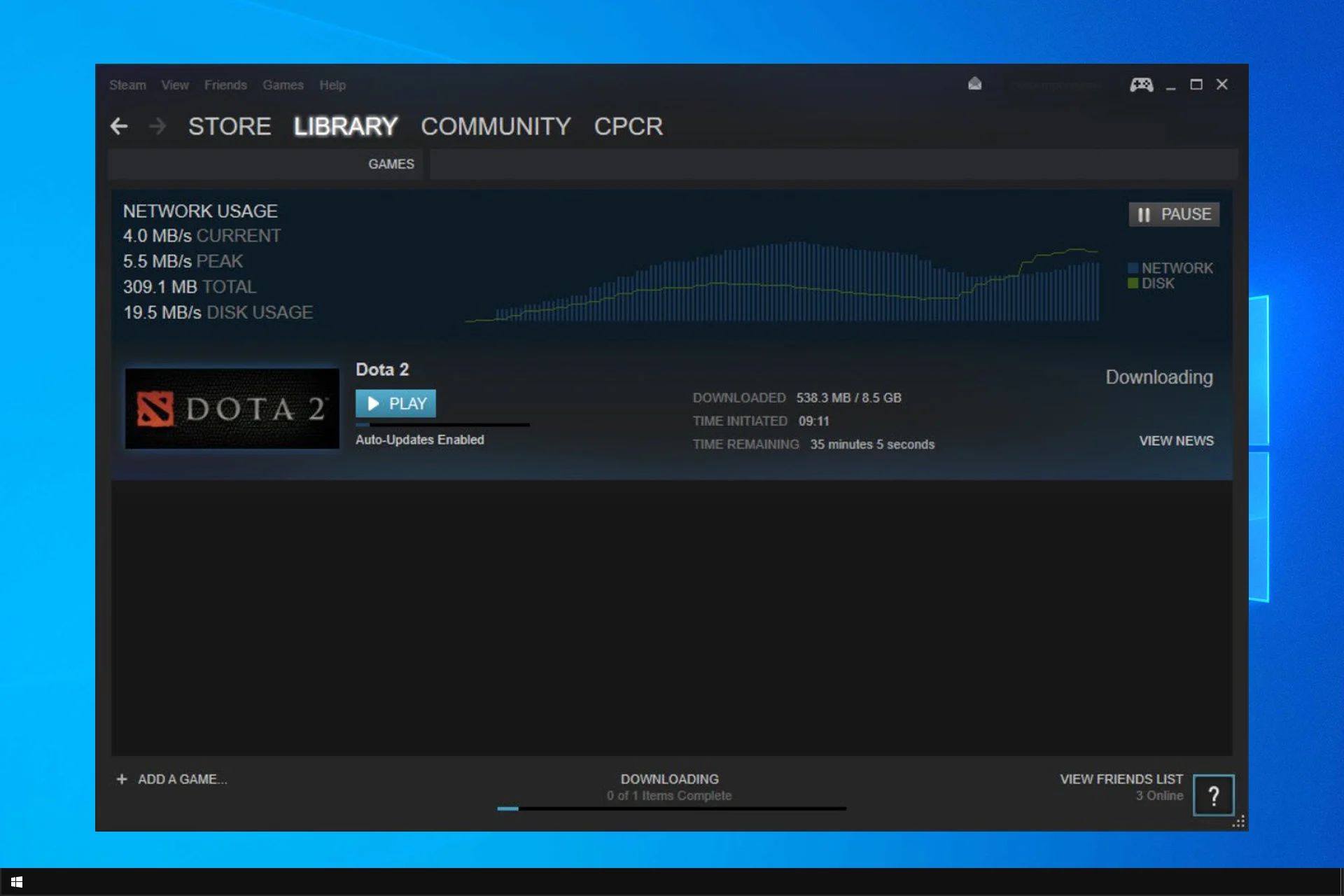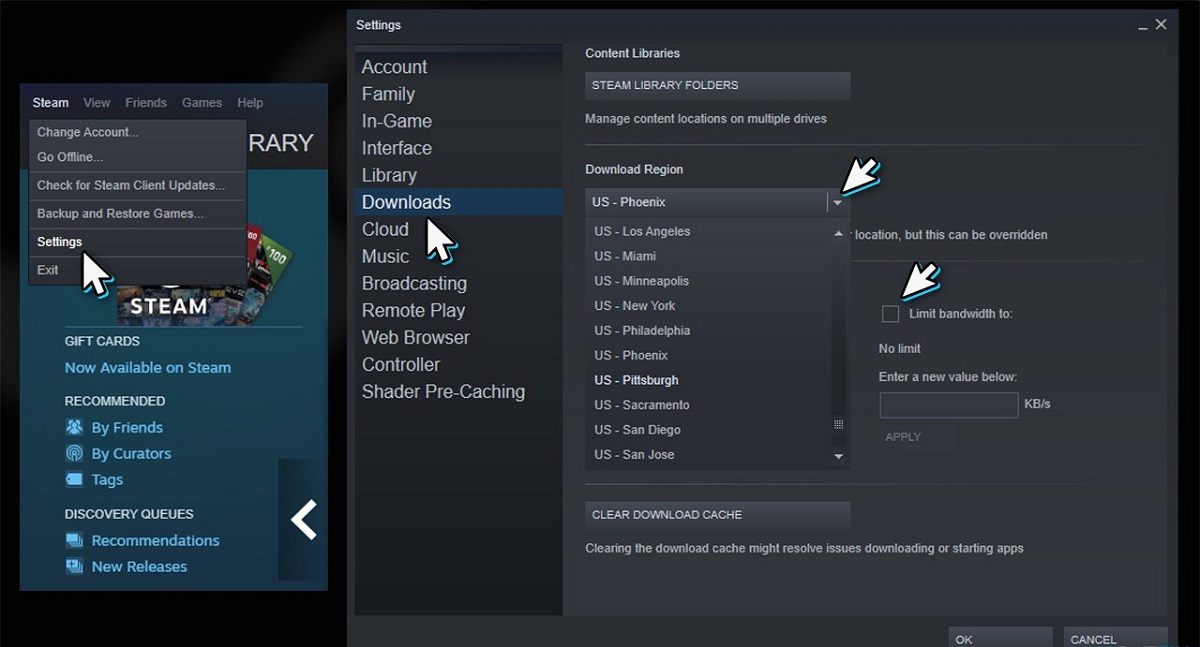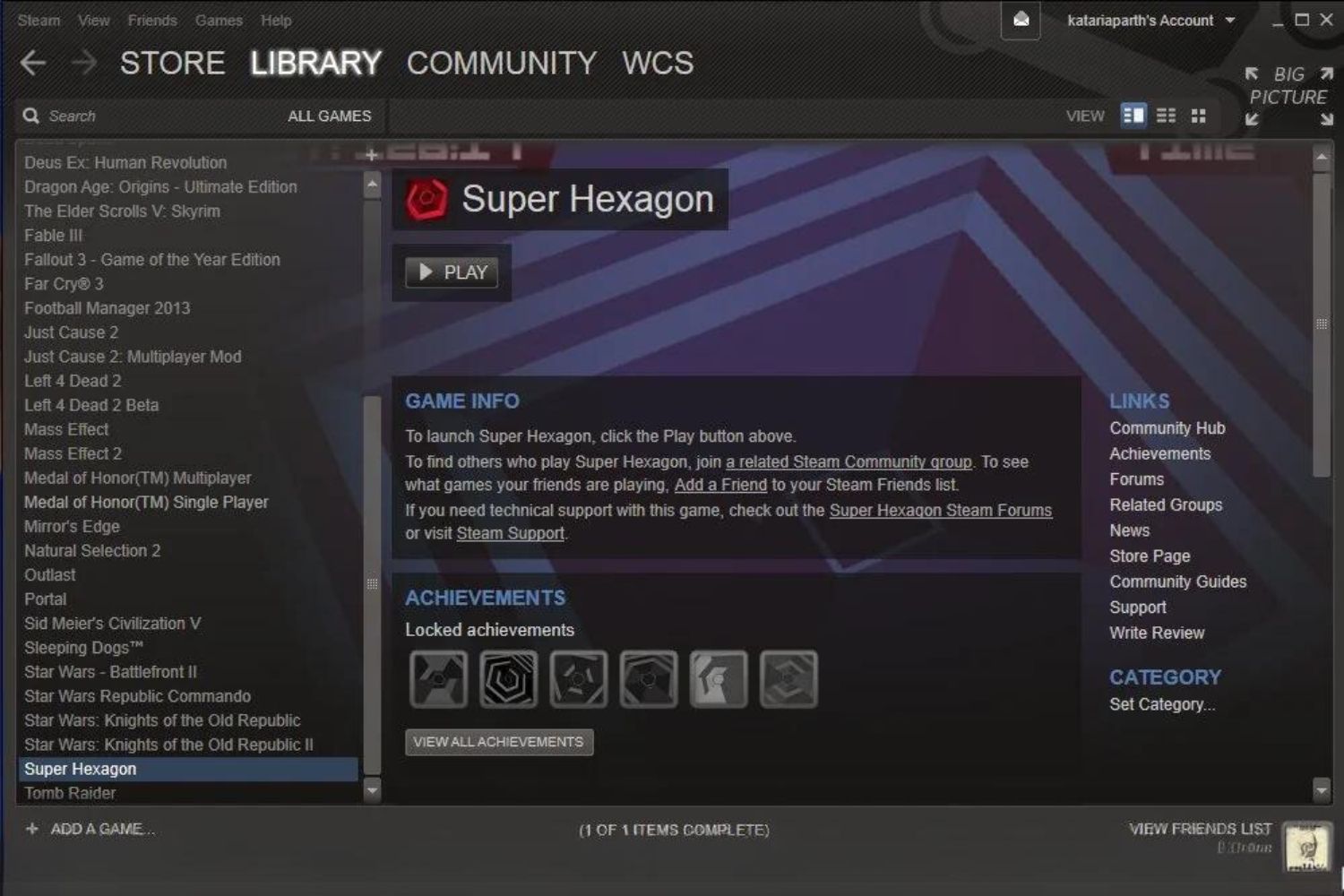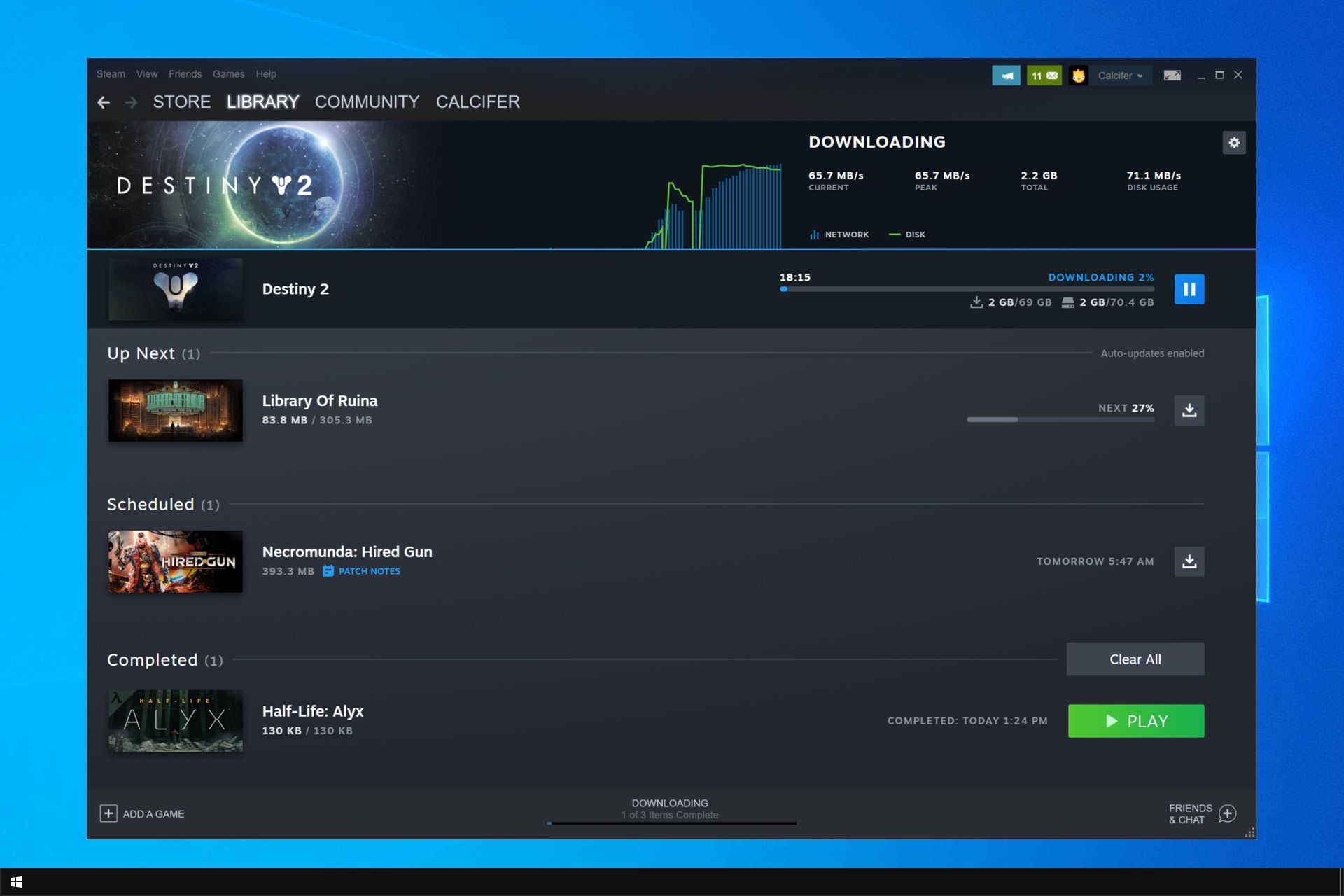Introduction
Welcome to the world of Steam, the go-to platform for gamers to purchase and download their favorite games. However, one common frustration that many Steam users face is the slow download speeds that can hinder their gaming experience. If you find yourself waiting hours for a game to download, you’ve come to the right place. In this article, we will explore various methods to make Steam download games faster, so you can start gaming sooner.
Steam is a digital distribution platform developed by Valve Corporation, offering a vast library of games for personal computers. It allows users to purchase, download, and play games, as well as connect with other gamers through its social features. While Steam provides excellent convenience and a wide range of games, slow download speeds can dampen the excitement of getting a new game. Fortunately, there are several steps you can take to optimize your download speed and minimize the waiting time.
By following the tips and techniques outlined in this guide, you will be able to maximize your download speed and enjoy seamless gaming experiences. Whether you have a slow internet connection or overwhelming competition for bandwidth, these strategies will help you get the most out of your Steam downloads. So, without further ado, let’s dive into the methods that will supercharge your Steam download speeds and get you gaming in no time!
Check your Internet Connection
Before troubleshooting any issues with Steam download speeds, it’s essential to ensure that your internet connection is stable and functioning optimally. Here are a few steps to check your internet connection:
- Confirm your internet speed: Use an online speed test tool to check your internet speed. Make sure you have a reliable and stable connection with a sufficient download speed for smooth gaming.
- Reset your modem and router: Sometimes, a simple restart of your modem and router can help resolve connectivity issues and improve download speeds. Unplug them from the power source, wait for a few seconds, and then plug them back in.
- Use a wired connection: If you’re using a Wi-Fi connection, consider switching to a wired connection using an Ethernet cable. Wired connections generally offer more stability and faster speeds compared to wireless connections.
- Check for background downloads and uploads: Close any applications or devices on your network that may be using up bandwidth, such as other downloads, file transfers, or streaming services.
- Disable VPN or proxy: If you’re using a VPN or proxy service, try disabling it temporarily. These services can sometimes slow down your internet connection, affecting Steam download speeds.
By checking and optimizing your internet connection, you can eliminate any potential issues that may be causing slow download speeds on Steam. Once you have confirmed that your internet connection is stable and fast, you can proceed to the next steps to optimize your Steam download settings.
Adjust Steam Download Settings
After ensuring that your internet connection is stable, the next step to improve Steam download speeds is to adjust the download settings within the Steam client. Here are a few settings you can modify:
- Change the download region: Steam allows you to select a specific download region. Sometimes, certain regions can have high traffic or limited server capacity, resulting in slower download speeds. Navigate to the “Steam” menu, select “Settings,” and go to the “Downloads” tab. From there, you can choose a different download region that is closer to your location and has more stable servers.
- Limit your bandwidth: Steam offers an option to limit the bandwidth used for downloads. If you find that Steam is hogging all your available bandwidth, you can set a limit under the “Downloads” tab in the Steam settings. By doing so, you can free up some bandwidth for other tasks while still maintaining a decent download speed on Steam.
- Enable “Allow downloads during gameplay”: If you’d like to continue playing games on Steam while downloading in the background, make sure the “Allow downloads during gameplay” option is enabled. You can find this option in the “Downloads” tab of the Steam settings. Keep in mind that enabling this option may slightly reduce your in-game performance.
- Change the download cache location: By default, Steam saves its download cache in a specific location on your hard drive. If you have multiple drives, consider changing the download cache location to a drive with faster read and write speeds to boost your download performance. You can modify this setting under the “Downloads” tab in the Steam settings.
- Enable “Automatically download updates for games”: Ensure that the option to automatically download updates for games is enabled. This setting can be found in the “Downloads” tab of Steam settings. By allowing automatic updates, you can ensure that your games are always up to date without having to wait for manual downloads.
By adjusting these settings according to your preferences and network conditions, you can significantly enhance your download speeds on Steam. Take some time to experiment with different configurations until you find the optimal settings that work best for you.
Change your Download Region
One effective way to improve Steam download speeds is by changing your download region. Steam allows you to select a specific download region that corresponds to a server location. Here’s how you can change your download region:
- Open Steam: Launch the Steam client on your computer.
- Go to Settings: Click on the “Steam” menu in the top left corner of the Steam client, and select “Settings” from the drop-down menu.
- Select Downloads: In the Settings menu, click on the “Downloads” tab on the left-hand side.
- Choose a new Download Region: Under the “Download region” section, you will see a drop-down menu with a list of available regions. Select a different region that is closer to your physical location.
- Apply the changes: After selecting the new download region, click on the “OK” button at the bottom of the Settings window to save the changes.
Changing your download region allows Steam to connect to a different server location, which may result in faster download speeds. It’s recommended to choose a region that is geographically closer to your location, as this reduces the distance between your computer and the Steam server, resulting in lower latency and improved download speeds.
Keep in mind that certain regions may have higher traffic or limited server capacity, which can affect download speeds. Therefore, it might be worth trying different regions to find the one with the best performance. You can always go back to the default region if the change does not improve your download speeds.
By experimenting with different download regions and selecting the one that offers the best performance, you can significantly enhance your download speeds on Steam and reduce the time it takes to download your favorite games.
Clear Steam Download Cache
If you’re experiencing sluggish download speeds on Steam, one effective troubleshooting step is to clear the Steam download cache. The download cache stores temporary files related to game downloads and can sometimes become corrupted or overloaded, leading to decreased performance. Here’s how you can clear the Steam download cache:
- Exit Steam: Close the Steam client to ensure that it is not running in the background.
- Delete the Steam cache files: Open the file explorer on your computer and navigate to the Steam installation directory. The default location is typically “C:\Program Files (x86)\Steam” on Windows and “/Applications/Steam” on Mac.
- Locate the “SteamApps” folder: Within the Steam installation directory, find and open the “SteamApps” folder.
- Delete the “downloading” folder: Inside the “SteamApps” folder, look for the “downloading” folder and delete it. This folder contains partially downloaded game files, and removing it will clear the download cache.
- Restart Steam: After deleting the “downloading” folder, relaunch the Steam client. It will automatically recreate the necessary files and folders.
By clearing the Steam download cache, you are essentially starting fresh and removing any potential issues that may be affecting your download speeds. This process can also help resolve any corrupted files that could be causing slow downloads.
It’s important to note that clearing the Steam download cache will not affect your installed games or personal settings. You will simply need to re-download any games that were actively downloading when you cleared the cache.
After clearing the Steam download cache and restarting the client, monitor your download speeds to see if there is an improvement. If the issue persists, continue exploring the other methods mentioned in this article to further optimize your Steam download speeds.
Disable Background Applications and Downloads
Running multiple applications and downloads simultaneously can consume valuable system resources and bandwidth, leading to slower download speeds on Steam. By disabling unnecessary background applications and downloads, you can prioritize resources towards your Steam download and maximize your download speeds. Here’s what you can do:
- Close unnecessary applications: Before initiating a Steam download, close any non-essential applications running in the background. These applications can include web browsers, media players, file-sharing programs, or any other software that may be using up system resources or internet bandwidth.
- Pause or cancel other downloads or updates: If you have other ongoing downloads, updates, or file transfers, consider pausing or canceling them temporarily. This will free up bandwidth for your Steam download, allowing it to utilize more resources and potentially increase download speeds.
- Disable cloud backup or synchronization: Some applications, such as cloud storage services, automatically sync files in the background. This process consumes both system resources and internet bandwidth. Disable or pause any cloud backup or synchronization services during your Steam download to maximize available resources.
- Check for Windows updates: Windows updates can sometimes run in the background and consume system resources. Make sure to check for pending updates and allow them to complete before initiating a Steam download. Updating your operating system can also help optimize your system’s performance.
- Manage background processes: Open the Task Manager on your computer (Ctrl+Shift+Esc on Windows or Command+Space then type “Activity Monitor” on Mac) and navigate to the “Processes” or “Activity Monitor” tab. Look for any unnecessary processes or tasks that are consuming system resources and terminate them to free up resources for your Steam download.
By disabling or pausing unnecessary background applications, downloads, and processes, you provide more bandwidth and resources for your Steam download, leading to faster and smoother downloads. Remember to re-enable any disabled applications or processes once your Steam download has completed.
Optimizing your computer’s resources by eliminating background activities is a crucial step towards improving your download speeds on Steam. By giving Steam the necessary resources, you can ensure that your downloads are completed in a timely manner, allowing you to start playing your favorite games without any delays.
Close Unnecessary Programs and Processes
When it comes to optimizing your download speeds on Steam, closing unnecessary programs and processes can make a significant difference. By freeing up system resources, you allow Steam to utilize more resources for the download, resulting in faster and more efficient downloads. Follow these steps to close unnecessary programs and processes:
- Identify resource-intensive programs: Open the Task Manager (Ctrl+Shift+Esc on Windows or Command+Space, then type “Activity Monitor” on Mac) to see a list of active programs and processes. Look for programs that are consuming a significant amount of CPU, memory, or network resources.
- Close resource-intensive programs: Select the programs that you don’t need to use while downloading games on Steam, right-click on them, and choose “End Task” (Windows) or “Quit” (Mac) to close them completely.
- Disable unnecessary startup programs: Some programs automatically start when you boot your computer, consuming system resources. Disable any unnecessary startup programs to prevent them from running in the background and interfering with your Steam download.
- End unnecessary processes: In the Task Manager or Activity Monitor, go to the “Processes” or “Activity Monitor” tab. Look for processes that are not essential to your system’s functioning or related to your Steam download. Right-click on these processes and select “End Task” (Windows) or “Quit” (Mac) to terminate them.
- Check for background services: Some programs run background services that continue to consume system resources even when the main program is closed. Look for any unnecessary background services and disable or stop them to free up resources for your Steam download.
By closing unnecessary programs, disabling startup programs, and terminating unnecessary processes, you effectively allocate more resources to your Steam download. This optimization ensures that Steam receives the maximum available resources, resulting in faster download speeds and a smoother gaming experience.
Remember to only close programs and processes that are not necessary for your computer’s functioning. Be cautious and avoid terminating any processes or services that are critical to the operating system or the functioning of other applications.
By following these steps and freeing up system resources, you can improve your download speeds on Steam and enjoy faster downloads for your favorite games.
Pause and Resume the Download
If you’re experiencing slow download speeds on Steam, one technique you can try is pausing and resuming the download. Sometimes, downloads can get stuck or encounter issues that hinder their progress. By pausing and resuming the download, you can refresh the connection and potentially improve the download speed. Follow these steps to pause and resume a download on Steam:
- Open the downloads page: In the Steam client, click on the “Library” tab at the top, and then select “Downloads” from the drop-down menu. This will open the downloads page, where you can see the progress of your downloads.
- Pause the download: Locate the game or update that you want to pause, and click on the “Pause” button next to it. This will temporarily stop the download process.
- Wait for a few seconds: After pausing the download, wait for about 10-15 seconds before resuming it. This brief pause allows the connection to reset.
- Resume the download: Click on the “Resume” button next to the paused game or update to restart the download process. Steam will attempt to establish a new connection and resume the download from where it left off.
By pausing and resuming the download, you give Steam an opportunity to re-establish a fresh connection, which can result in improved download speeds. This method is particularly useful if you’ve been experiencing slow speeds or the download has been stuck at a certain percentage for an extended period.
Additionally, you can try pausing and resuming the download multiple times if the speed doesn’t improve initially. Sometimes, it may take a few attempts for Steam to establish a stable and faster connection with its servers.
Remember that the effectiveness of this method may vary depending on various factors such as your internet connection, server load, and distance from Steam’s servers. If pausing and resuming the download doesn’t significantly improve the speed, consider trying other methods mentioned in this article.
By utilizing the pause and resume feature in Steam, you have a simple yet effective technique to potentially enhance your download speeds and reduce the time it takes to get your games up and running.
Use a Wired Connection
When it comes to optimizing your download speed on Steam, using a wired internet connection can greatly improve your experience. While Wi-Fi offers convenience and mobility, a wired connection provides more stability and consistent speeds. Here’s why you should consider using a wired connection for your Steam downloads:
Enhanced Stability and Speed: Wired connections, such as Ethernet cables, provide a direct and stable connection between your computer and the router. This reduces the chances of signal interference and ensures a more reliable and consistent internet connection, which ultimately translates into faster and more reliable download speeds. Wi-Fi signals can sometimes be affected by obstacles, interference from other devices, or distance from the router, causing fluctuations in download speeds.
Reduced Latency: Wired connections typically have lower latency (also known as ping), resulting in a more responsive and lag-free gaming experience. This is particularly important for online multiplayer games that require real-time interaction. Lower latency improves the overall gaming experience by reducing input delay and enhancing competitiveness.
Elimination of Signal Interference: Wi-Fi signals can be disrupted by other electronic devices, neighboring networks, or physical barriers like walls and floors. Using a wired connection eliminates these potential sources of interference, allowing for a more stable and consistent connection. As a result, you can experience faster and more consistent download speeds on Steam.
Easy Setup: Setting up a wired connection is straightforward. Simply connect an Ethernet cable from your computer or laptop to the router or modem. Most modern computers and laptops come equipped with Ethernet ports, making it easy to establish a wired connection without any additional hardware.
Network Prioritization: If you have other devices connected to the same network, using a wired connection for your gaming computer allows you to prioritize network traffic. By giving priority to your Steam downloads over other devices, you can ensure that your gaming experience is not impacted by competing bandwidth demands from other devices.
Overall, using a wired connection for your Steam downloads provides greater stability, reduced latency, and improved download speeds. While Wi-Fi may be suitable for casual browsing or streaming, a wired connection is the optimal choice for gamers who seek the best performance from their Steam downloads. So, if you have the option to connect your computer directly to the router via Ethernet, it’s definitely worth considering for an optimal gaming experience.
Limit Steam Download Speed
If you want to ensure a seamless online experience while downloading games on Steam, you can limit the download speed to prevent it from consuming all of your available bandwidth. By limiting the download speed, you can still download games while maintaining a stable internet connection for other activities. Here’s how you can do it:
- Open Steam client: Launch the Steam client on your computer.
- Go to Settings: Click on the “Steam” menu in the top-left corner of the Steam client and select “Settings” from the dropdown menu.
- Select Downloads: In the Settings menu, click on the “Downloads” tab on the left-hand side.
- Set a download limit: Under the “Download restrictions” section, you will find an option to “Limit bandwidth to.” Adjust the value according to your preference, such as 500 KB/s, 1 MB/s, or any desired limit.
- Apply the changes: After setting the desired download limit, click on the “OK” button at the bottom of the Settings window to save the changes.
By limiting the download speed on Steam, you ensure that it doesn’t consume all of your available bandwidth, allowing you to perform other online activities without interruptions. This is particularly useful if you share your internet connection with other devices or users who also require a stable connection.
Keep in mind that limiting the download speed may increase the overall time required to download a game, especially for larger files. However, it allows for a more balanced use of your internet connection and prevents any adverse impact on other essential activities, such as video streaming, online gaming, or video conferencing.
It’s worth mentioning that you can adjust the download speed limit based on your specific bandwidth capacity and requirements. If you have a faster internet connection, you may set a higher limit for Steam downloads without affecting other online activities. Conversely, if you have a slower internet connection or need to prioritize other activities, you can set a lower limit to ensure a stable connection.
By utilizing the download speed limit feature in Steam, you can maintain a consistent internet connection and perform other online tasks while still enjoying the convenience of downloading games from the platform.
Update your Graphics and Network Drivers
Outdated or faulty drivers can often cause performance issues, including slow download speeds on Steam. By keeping your graphics and network drivers up to date, you can ensure optimal performance and enhance your Steam download speeds. Here’s how you can update your drivers:
- Identify your graphics and network hardware: Determine the make and model of your graphics card and network adapter. You can usually find this information in the Device Manager on Windows or the System Information on Mac.
- Visit the manufacturer’s website: Go to the website of your graphics card manufacturer (e.g., NVIDIA, AMD, Intel) and network adapter manufacturer (e.g., Realtek, Broadcom). Navigate to the support or drivers section of the website.
- Download the latest drivers: Locate the drivers section for your specific hardware model and download the latest version of the drivers compatible with your operating system. Make sure to download the correct drivers for your specific hardware model.
- Install the updated drivers: Once the drivers are downloaded, run the installer and follow the on-screen instructions to install the updated drivers. It is recommended to select the “Clean Install” option if available, which ensures that any previous driver remnants are completely removed.
- Restart your computer: After the driver installation is complete, restart your computer to allow the changes to take effect.
Updating your graphics and network drivers can resolve compatibility issues, optimize performance, and improve overall system stability. By ensuring that your hardware is running on the latest drivers, you provide the best conditions for Steam downloads to operate at their optimum speeds.
Outdated drivers can lead to performance bottlenecks and hinder your download speeds, as well as introduce other issues such as graphical glitches, connectivity problems, or system crashes. Regularly updating your drivers helps to eliminate these issues and keeps your system running smoothly.
In addition to updating graphics and network drivers, it is also recommended to update other drivers, such as audio, chipset, and firmware, if updates are available. This comprehensive approach ensures that your system is optimized for performance across all aspects, resulting in improved download speeds and an overall better gaming experience.
By investing a little time to keep your drivers up to date, you can eliminate potential performance bottlenecks and ensure that your hardware is fully optimized for Steam downloads and other demanding tasks.
Conclusion
Slow download speeds on Steam can be frustrating, but by implementing the techniques and strategies outlined in this article, you can significantly improve your Steam download experience. Here’s a quick recap of the methods discussed:
- Check your internet connection to ensure it is stable and up to speed.
- Adjust the Steam download settings, such as changing the download region and limiting bandwidth.
- Clear the Steam download cache to remove any potential issues or corrupted files.
- Close unnecessary programs and processes that may be using up system resources or bandwidth.
- Pause and resume the download to refresh the connection and potentially improve speeds.
- Consider using a wired connection for a more stable and consistent internet connection.
- Limit the download speed to prevent Steam from hogging all available bandwidth.
- Update your graphics and network drivers to ensure optimal performance.
Remember that the effectiveness of these methods may vary depending on factors such as your internet connection, hardware, server load, and regional limitations. It’s always a good idea to try multiple methods and experiment to find the combination that works best for you.
By following these steps, you can enhance your download speeds on Steam, reducing waiting times and enabling you to dive into your favorite games more quickly. Enjoy the uninterrupted gaming experience and get ready to embark on countless adventures as you explore the vast world of Steam!







